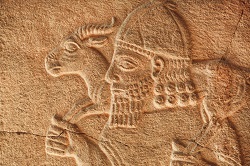Genetic identities of the world’s first farmers revealed
The study, published in the journal ‘Nature’, has illuminated the genetic identities and population dynamics of the world’s first farmers. They achieved this by undertaking pioneering large-scale, genome-wide analyses of ancient human remains from the Near East. Newly described groups The study reveals three genetically distinct farming populations living in the Near East 12 000 to 8 000 years ago, which includes two newly described groups from what is now Iran and the Levant, and a previously reported group in Anatolia, part of modern-day Turkey. The findings also suggest that agriculture spread through the Near East at least in part because existing groups invented or adopted farming technologies, rather than because one specific population replaced another. ‘Some of the earliest farming was practiced in the Levant, including Israel and Jordan, and in the Zagros mountains of Iran – two edges of the Fertile Crescent,’ commented Professor Ron Pinhasi, of University College Dublin, a co-senior author of the study. ‘We wanted to find out whether these early farmers were genetically similar to one another or to the hunter-gatherers who lived there before so we could learn more about how the world’s first agricultural transition occurred.’ The analyses conducted by the team have altered what we know about the genetic heritage of modern people in Western Eurasia. They now appear to be descended from four major groups: hunter-gatherers in what is now Western Europe, hunter-gatherers in Eastern Europe and the Russian steppe, the Iran farming group, and the Levant farming group. Professor David Reich, another co-senior author from Harvard Medical School commented: ‘We found that the relatively homogenous population seen across Western Eurasia today, including Europe and the Near East, used to be a highly sub-structured collection of people who were as different from one another as present-day Europeans are from East Asians.’ Near East populations mixed with one another over time and migrated into surrounding regions to mix with the people living there until those initially quite diverse groups became genetically very similar. Overcoming poor-quality DNA remains Advances in ancient-DNA technology have made it possible to probe population mixing and large-scale migrations that occurred thousands of years ago but the Near East has been one of the most challenging regions in which to successfully do this. This is due to the region’s warm climate and the subsequent degradation of DNA in unearthed bones. The team overcame this problem in part by extracting genetic material from ear bones that can yield up to 100 times more DNA than other bones in the body. They also used a technique called in-solution hybridisation to enrich for human DNA and filter out contaminant DNA from microbes. The combined technique allowed researchers to gather high-quality genomic information from 44 ancient Near Easterners who lived between 14 000 and 3 400 years ago. These included hunter-gatherers before the advent of farming, the first farmers themselves, and their successors. By comparing the genomes not only to each other but to 240 previously studied ancients from nearby regions and from around 2 600 present-day people, the researchers learnt that the first farming cultures in the Levant, Iran and Anatolia were all genetically distinct. ‘Maybe one group domesticated goats and another began growing wheat, and the practices were shared in some way,’ speculated research team member Iosif Lazaridis. ‘These different populations all invented or adopted some facets of the farming revolution, and they all flourished.’ Over the following 5 000 years, the Near East farming groups mixed with one another and with hunter-gatherers in Europe. By the Bronze Age, populations had ancestry from many sources and broadly resembled present-day ones. The descendants of each farming group, even as they began to intermingle, contributed to the genetic ancestry of people from other parts of the world. Farmers related to the Anatolian group spread west into Europe, people related to the Levant group moved to East Africa, people related to those in Iran or the Caucasus went north to the Russian steppe, and people related both to the farmers in Iran and hunter-gatherers from the steppe spread to South Asia. ‘The Near East was the missing link to understanding many human migrations,’ stated Pinhasi. Going forward, the research team are eager to study remains from the world’s first civilisations which succeeded the samples analysed in this particular study. For more information please see: CORDIS project page
Countries
Ireland



